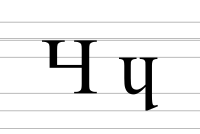Turned H (uppercase: Ɥ, lowercase: ɥ) is an additional letter of the Latin alphabet, based on a turned form of H. It is used in the Dan language in Liberia.[1] Its lowercase form is used in the International Phonetic Alphabet to represent the voiced labial–palatal approximant. It was also historically used in the Abaza, Abkhaz, and the Vassali Maltese alphabet.
| Ɥ | |
|---|---|
| Ɥ ɥ | |
 | |
| Usage | |
| Writing system | Latin script |
| Type | Alphabetic and Logographic |
| In Unicode | U+A78D, U+0265 |
| History | |
| Development |
|
| Other | |
| Writing direction | Left-to-Right |
Usage
editAn early usage of turned h appeared in Benjamin Franklin's phonetic alphabet where it represented [ʌ].[2]
During Latinisation, the letter would appear in the Abaza Latin alphabet of 1932 where it denoted the sound [t͡ɕ], and in the Abkhaz Latin alphabet of 1924 where it denoted the sound [t͡ʃʰ].[3] The letter also appeared in the Vassalli Maltese alphabet, and the Metelko alphabet for Slovene, where it stood for the sound [t͡ʃ].
In the Metelko alphabet, Maltese, Abaza, and Abkhaz languages, the letter had a capital form Ч, identical to the Cyrillic letter Che. This letter was also used in the first version of Unifon.[4]
References
edit- ^ Lorna A. Priest (2008-04-23). "Proposal to Encode Additional Latin and Cyrillic Characters" (PDF). Retrieved 2021-09-18.
- ^ Franklin, Benjamin. A Reformed Mode of Spelling. In Political, Miscellaneous, and Philosophical Pieces, pages 467-478. London, 1779.
- ^ "Proposal to encode Latin letters used in the Former Soviet Union" (PDF). 2011-10-18. Retrieved 2021-09-18.
- ^ Michael Everson (2012-04-29). "Proposal to encode "Unifon" and other characters in the UCS" (PDF). Retrieved 2021-09-18.